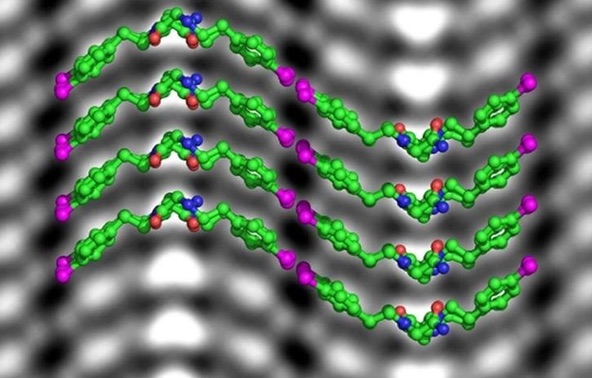Researchers have created thin, paper-like crystalline sheets using a synthetic, protein-like molecule called a polypeptoid. These nanosheets are only one molecule thick, with the molecules arranged in very specific ways. Scientists take images of these nanosheets using electron microscopes under cryogenic conditions. Until recently these images were blurry because of the tiny number of electrons that can pass through the sheets without causing damage. In this study, researchers used algorithms based on machine learning to process about 500,000 independent images. The result is the first clear, real-space image of individual atoms in a synthetic soft material.
The Impact
Synthetic polymers are essential for many products that we take for granted. These range from plastic furniture to fuselages of modern airplanes. They also lie at the heart of devices like fuel cells and rechargeable batteries. These devices are becoming increasingly important in the emerging clean energy landscape. All of the important properties of synthetic polymers depend on the arrangement of their atoms. Scientists’ ability to position individual atoms in polymeric materials will improve our understanding of the bottlenecks that limit the performance of synthetic polymers. This research also marks an important step in nanoscience as a whole.
Summary
For the first time, scientists revealed the atomic structural details of a synthetic soft material. Peptoid diblock copolymers consists of two different protein-like chains that are bonded together. These materials were designed to fit tightly with one another to form highly organized crystalline sheets in water. Individual molecules and their relative orientations within the nanosheets were directly observed by cryogenic transmission electron microscopy (cryo-TEM), revealing atomic details in position space inaccessible by conventional scattering techniques. The ultracold temperature used to flash-freeze the nanosheets effectively locked the molecules in place. Imaging the sample under cryogenic conditions helped prevent the energetic electrons from destroying the structure. To further protect the soft materials from the electron beam, the researchers used fewer electrons per image. Images obtained under these conditions were processed using sophisticated mathematical tools and machine learning algorithms to produce high-resolution pictures of the atomic scale structure.
The combined precision synthesis of peptoid polymers, atomic-imaging of cryo-TEM, and computational modeling helped scientists understand the atomic level polymer structures. Researchers are now able to make atomic-level edits to design targeted molecules. This paves the way to rationally engineer sophisticated functions into soft materials through systematic control of their chemical structure. The research was conducted in part at two Department of Energy user facilities, the Molecular Foundry and the Advanced Light Source.
Funding
This work was funded by the Department of Energy Office of Science, Office of Basic Energy Sciences, Materials Sciences and Engineering Division. Work at the Molecular Foundry and the Advanced Light Source at Lawrence Berkeley National Laboratory was supported by user projects at these user facilities, supported by the Department of Energy Office of Science, Office of Basic Energy Sciences. Micrographs presented here were obtained at the Donner Cryo-TEM facility at Lawrence Berkeley National Lab and the Berkeley Bay Area Cryo-TEM facility in UC Berkeley.















